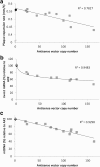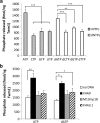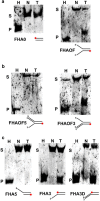The Dictyostelium discoideum homologue of Twinkle, Twm1, is a mitochondrial DNA helicase, an active primase and promotes mitochondrial DNA replication
- PMID: 30563453
- PMCID: PMC6299598
- DOI: 10.1186/s12867-018-0114-7
The Dictyostelium discoideum homologue of Twinkle, Twm1, is a mitochondrial DNA helicase, an active primase and promotes mitochondrial DNA replication
Abstract
Background: DNA replication requires contributions from various proteins, such as DNA helicases; in mitochondria Twinkle is important for maintaining and replicating mitochondrial DNA. Twinkle helicases are predicted to also possess primase activity, as has been shown in plants; however this activity appears to have been lost in metazoans. Given this, the study of Twinkle in other organisms is required to better understand the evolution of this family and the roles it performs within mitochondria.
Results: Here we describe the characterization of a Twinkle homologue, Twm1, in the amoeba Dictyostelium discoideum, a model organism for mitochondrial genetics and disease. We show that Twm1 is important for mitochondrial function as it maintains mitochondrial DNA copy number in vivo. Twm1 is a helicase which unwinds DNA resembling open forks, although it can act upon substrates with a single 3' overhang, albeit less efficiently. Furthermore, unlike human Twinkle, Twm1 has primase activity in vitro. Finally, using a novel in bacterio approach, we demonstrated that Twm1 promotes DNA replication.
Conclusions: We conclude that Twm1 is a replicative mitochondrial DNA helicase which is capable of priming DNA for replication. Our results also suggest that non-metazoan Twinkle could function in the initiation of mitochondrial DNA replication. While further work is required, this study has illuminated several alternative processes of mitochondrial DNA maintenance which might also be performed by the Twinkle family of helicases.
Keywords: DNA helicase; DNA primase; Dictyostelium discoideum; Mitochondrial DNA replication; Twinkle.
Figures









Similar articles
-
The N-terminal domain of human mitochondrial helicase Twinkle has DNA-binding activity crucial for supporting processive DNA synthesis by polymerase γ.J Biol Chem. 2023 Jan;299(1):102797. doi: 10.1016/j.jbc.2022.102797. Epub 2022 Dec 14. J Biol Chem. 2023. PMID: 36528058 Free PMC article.
-
The plant organellar primase-helicase directs template recognition and primosome assembly via its zinc finger domain.BMC Plant Biol. 2023 Oct 6;23(1):467. doi: 10.1186/s12870-023-04477-4. BMC Plant Biol. 2023. PMID: 37803262 Free PMC article.
-
Twinkle, the mitochondrial replicative DNA helicase, is widespread in the eukaryotic radiation and may also be the mitochondrial DNA primase in most eukaryotes.J Mol Evol. 2006 May;62(5):588-99. doi: 10.1007/s00239-005-0162-8. Epub 2006 Apr 11. J Mol Evol. 2006. PMID: 16612544
-
TWINKLE and Other Human Mitochondrial DNA Helicases: Structure, Function and Disease.Genes (Basel). 2020 Apr 9;11(4):408. doi: 10.3390/genes11040408. Genes (Basel). 2020. PMID: 32283748 Free PMC article. Review.
-
Minireview: DNA replication in plant mitochondria.Mitochondrion. 2014 Nov;19 Pt B:231-7. doi: 10.1016/j.mito.2014.03.008. Epub 2014 Mar 26. Mitochondrion. 2014. PMID: 24681310 Free PMC article. Review.
Cited by
-
The N-terminal domain of human mitochondrial helicase Twinkle has DNA-binding activity crucial for supporting processive DNA synthesis by polymerase γ.J Biol Chem. 2023 Jan;299(1):102797. doi: 10.1016/j.jbc.2022.102797. Epub 2022 Dec 14. J Biol Chem. 2023. PMID: 36528058 Free PMC article.
-
Structural and dynamic basis of DNA capture and translocation by mitochondrial Twinkle helicase.Nucleic Acids Res. 2022 Nov 11;50(20):11965-11978. doi: 10.1093/nar/gkac1089. Nucleic Acids Res. 2022. PMID: 36400570 Free PMC article.
-
Mutation of TWNK Gene Is One of the Reasons of Runting and Stunting Syndrome Characterized by mtDNA Depletion in Sex-Linked Dwarf Chicken.Front Cell Dev Biol. 2020 Jul 14;8:581. doi: 10.3389/fcell.2020.00581. eCollection 2020. Front Cell Dev Biol. 2020. PMID: 32766243 Free PMC article.
-
The plant organellar primase-helicase directs template recognition and primosome assembly via its zinc finger domain.BMC Plant Biol. 2023 Oct 6;23(1):467. doi: 10.1186/s12870-023-04477-4. BMC Plant Biol. 2023. PMID: 37803262 Free PMC article.
References
Publication types
MeSH terms
Substances
LinkOut - more resources
Full Text Sources
Molecular Biology Databases

